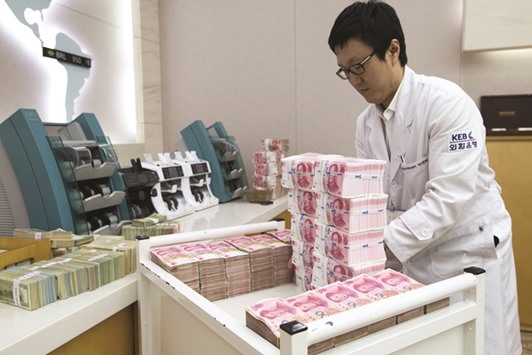As the dollar rally unravels, China’s currency is proving a remarkably steady partner.
The yuan has moved the least versus the dollar in the first quarter among non-pegged major currencies after the Canadian dollar. Its 0.9% gain versus the greenback compares with a 4.1% tumble in the Bloomberg Dollar Spot Index, while trade rivals such as South Korea and Taiwan have seen their currencies surge at least 6.9%.
Against such a negative backdrop for the greenback, pessimism about the yuan that was so pervasive just three months ago has ebbed. Bearish bets have fallen to near the lowest levels since January, while one-year forward contracts are the strongest they’ve been since November. At the same time, by keeping the yuan aligned with the dollar, China benefits from a steady depreciation against other countries.
Chinese policy makers will likely be keen to preserve stability in the yuan before a potential meeting between Presidents Donald Trump and Xi Jinping as soon as next month, when the US Treasury Department will publish its semi-annual report on trading partners’ foreign-exchange policy. A gauge of volatility in the yuan has dropped to the lowest among non- dollar-peg currencies around the world, after rising to a one- year high just two months ago.
“Yuan volatility will be very low in the foreseeable future as China keeps its currency stable ahead of the meeting between Xi and Trump and the US Treasury report,” said Irene Cheung, senior strategist for Asia at Australia & New Zealand Banking Group in Singapore.
After surging more than 7.1% last quarter in the wake of Trump’s shock victory, the Bloomberg Dollar Spot Index has slumped this year as optimism over the Republican’s stimulus plans foundered. The gauge of the greenback’s strength dropped as much as 0.7% to a four-month low on Monday after a failed US healthcare deal cast doubt on his ability to implement his economic agenda.
“Global funds are looking for value, and China’s currency stability is anchoring sentiment,” said Christy Tan, head of markets strategy and research for Asia at National Australia Bank in Hong Kong. “But investors need to be selective, given that the stability is partially engineered.”
The yuan’s one-month implied volatility, which is used to price options, was little changed at 3.45% in Shanghai, according to data compiled by Bloomberg. That’s compared with levels of more than 7% in early January. One-month contracts for the right to sell the yuan cost 0.15 percentage point more than those for purchases, data compiled by Bloomberg show. Twelve-month forwards on the Chinese currency were at 7.07 against the dollar.
While the onshore yuan has strengthened against the dollar this year, it has registered declines of 7%, 4.5% and 3.2% against the South Korean won, the Japanese yen and the Indian rupee, respectively. While China has repeatedly said the yuan’s rate is determined by market forces, it restricts moves to 2% on either side of a daily reference rate set by the central bank.

An employee arranges yuan banknotes at the Korea Exchange Bank headquarters in Seoul. The yuan has moved the least versus the dollar in the first quarter among non-pegged major currencies after the Canadian dollar.


